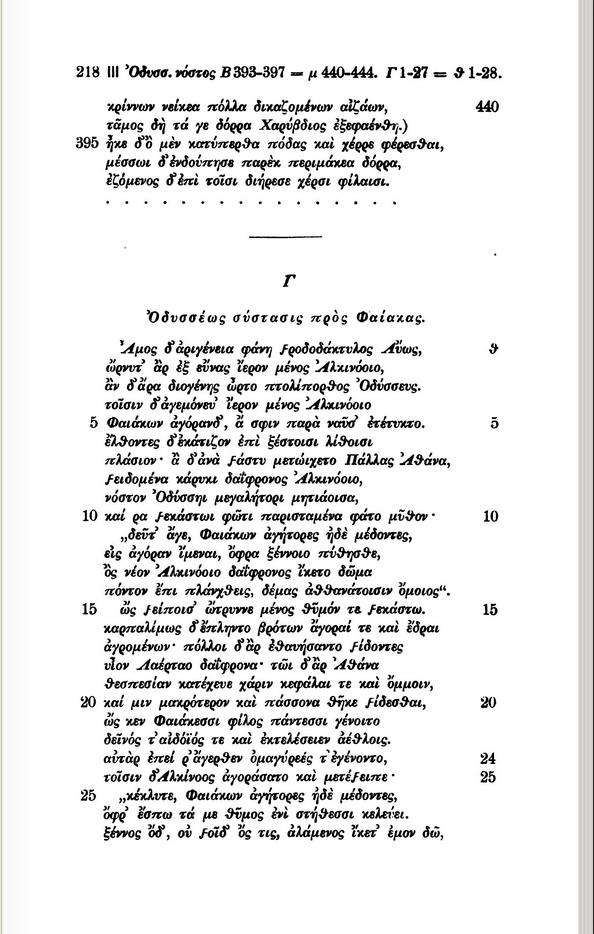In the final lines of Hesiod’s Theogony (1011-1016), we are told that Odysseus had two (or three) sons by Circe: Agrios and Latinos (and perhaps Telegonos), who ruled the Tyrsenians (a people in Italy [with the ethnic suffix -ηνός commonly found in Asia Minor and the Levant], if not actually the Etruscans who were later referred to as Tyrsenians/Tyrrenians). The parentage of this Latinus is problematic. Virgil does (Aeneid 12.164) and does not (Aeneid 7.47) present Circe as his mother. Hyginus (Fabulae 127) has Telemachus as his father.
One point of interest, although for another day, is the quantity of the i vowel in the suffix (assuming that it is a suffix): Λατῖνος. This is not the Greek suffix used to form adjectives (of material), such as λίθινος ‘made of stone’.
That is all by way of introducing a post on the Odyssey of Homer, not least because the Teubner edition by M.L. West has recently been published, but mainly because nearly two weeks ago I obtained a copy of the Odyssey as edited by Arthur Platt (Cambridge: Cambridge University Press, 1892), one of the ‘Cambridge Homer’ volumes.
‘The principle on which this edition is made is that of going back as far as is reasonably possible to the original language of Homer’ (Introduction, vii). For Platt, ‘original language’ means that digammas abound and contractions are resolved (infinitives in -εμεν from -ειν before Bucolic diaeresis; aorist 2 infinitives in -έεν from -έειν), among other instances of antiquing. This Odyssey has the complete Vulgate text in order (V 1-42, VIII 266-369, XI 568-629, and XXIII 297-end of XXIV, ‘the wretched conclusion’, are present, but bracketed). This Homer is thoroughly Ionic.
Here is the beginning of Book VIII (lines 11-25 featured in last year’s Part 1B exam and I, at least, have set them for a supervision later this term).

All this is far less radical than the ‘Aeolic Homer’ of Augustus Fick (Ilias, Odysseia). Here is the ‘same’ passage, now a third part (γ) in Part III, the (second) Return of Odysseus.

Digammas abound, but also the original long a-s for the eta of Ionic. Gemination is found for compensatory lengthening. Rosy-fingered Dawn is squarely Aeolic βροδοδάκτυλος Αὔως (line 1) and Odysseus has dual, not plural shoulders (line 19). I shall say no more, but leave readers and my supervisees to consider other points of linguistic interest in these restorations with the help of these visual aids.
For Fick, the Odyssey, or rather Part II, the Revenge of Odysseus, ended thus (cf. Od.23.296, the τέλος): ἀσπάσιοι λέκτροιο παλαίω θέσμον ἴκοντο (‘Glad they approached the assemblage of the old bed.’). (θεσμός was one of my first words for the Cambridge Greek Lexicon Project…).
This volume is no insignificant second-hand outdated book. For starters, I have had in mind to obtain a copy of Platt’s Odyssey ever since my Latin-Greek-Ancient History school master gave me his copy of Platt’s Iliad before I came up to Cambridge (a casket copy, if you will). Therein, Platt simply refers to his Odyssey for an explanation of his approach. Second, the marginal reference to Munro’s Homeric Grammar beside line 48 is not the only annotation.

This copy was bought from W. Heffer & Sons of Cambridge and belonged to none other than the Classical philosopher F.M. Cornford. Complete with a Heffer’s book mark, this Odyssey, bought online from Wigtown, has indeed come home. Not bad for £8 + P&P!





